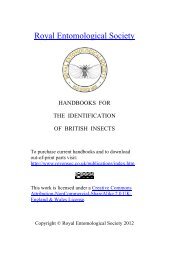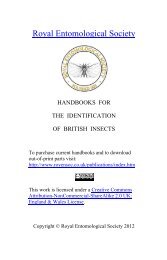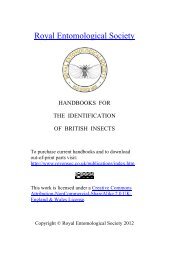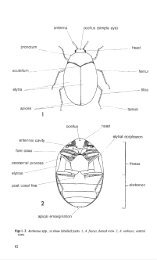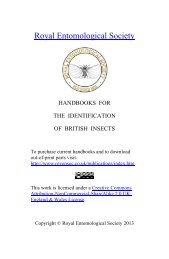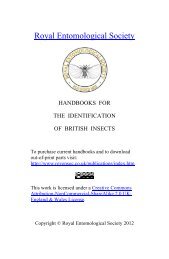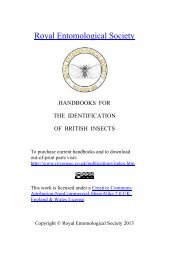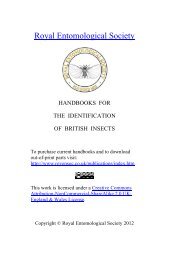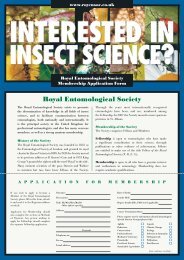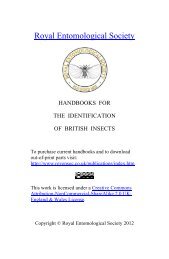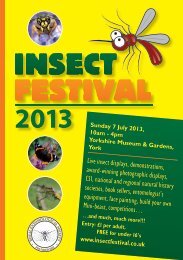Vol 10 Part 14. An introduction to the immature stages of British Flies ...
Vol 10 Part 14. An introduction to the immature stages of British Flies ...
Vol 10 Part 14. An introduction to the immature stages of British Flies ...
Create successful ePaper yourself
Turn your PDF publications into a flip-book with our unique Google optimized e-Paper software.
eliably identified by <strong>the</strong> key in Pinder (1978). A typical pupa is illustrated (fig. 1121)<br />
and a key <strong>to</strong> pupal exuviae is provided by Lang<strong>to</strong>n (1984).<br />
Eggs are laid in a protective gelatinous matrix and each subfamily appears <strong>to</strong> have<br />
a characteristic shape <strong>of</strong> egg and arrangement within <strong>the</strong> mass, e.g. linear type<br />
(Orthocladiinae, Diamesinae); compact type- spherical, tear or fig-shaped, or<br />
occasionally attached <strong>to</strong> a solid object by a gelatinous stalk (Tanypodinae,<br />
Chironominae) (figs 980-982).<br />
The life-his<strong>to</strong>ries <strong>of</strong>Chironomidae are reviewed by Oliver (1971) and a bibliography<br />
<strong>of</strong> Chironomidae is provided by Fittkau et al. (1976). Keys <strong>to</strong> larvae and pupae are<br />
provided by various authors in Wiederholm ( 1983, 1986). These are cited below, under<br />
subfamilies. This comprehensive work will also eventually cover pupae and adults, and<br />
reliable keys beyond genus are cited.<br />
The subfamilies may be distinguished in <strong>the</strong> larval stage as follows (after Crans<strong>to</strong>n<br />
1982).<br />
<strong>An</strong>tenna retractile in<strong>to</strong> head capsule (fig, 53, an); ligula strongly developed (fig. 53.lg)<br />
. . . . . . . . . . . . . . . . . . . . . . . Tanypodinae<br />
<strong>An</strong>tenna not retractile; ligula not strongly developed . . . . . . . . . . . 2<br />
2 Premandibles absent; procerci 8- <strong>10</strong> times as high as wide (fig. 59, pc) . . Polloaominae<br />
Premandibles present (fig. 54, pm); procerci rarely more than 4 times as high as wide 3<br />
3 Third antennal segment annulate (fig. 56) . . . . . . . . Diarwsiww (Diamesini)<br />
Third antennal segment not annulate . . . . . . . . . . . . . . . . 4<br />
4 <strong>An</strong>terior part <strong>of</strong> labrum (fig. 54, la) with a transverse row <strong>of</strong>'scales' (fig. 57) . . . . .<br />
. . . . . . . . . . . . . . . . . . . . Diamesiaar (Protanypini)<br />
Labrum without this row <strong>of</strong> 'scales' . . . . . . . . . . . . . . . . 5<br />
5 Ventral part <strong>of</strong> <strong>the</strong> mentum (fig. 54, m) expanded laterally <strong>to</strong> form ventromental plates which<br />
are usually striated (fig. 55) . . . . . . . . . . . . . . Cllirooominae<br />
Ventromental plates not striated . . . . . . . . . . . . . . . . . 6<br />
6 Ventromental plates well developed, extending beyond mentum by at least half <strong>of</strong> <strong>the</strong> width<br />
<strong>of</strong> <strong>the</strong> flattened mentum . . . . . . . . . . . . . . . Prodiamesinae<br />
Ventromental plates smaller, never extending beyond mentum by as much as half width <strong>of</strong><br />
flattened mentum . . . . . . . . . . . . . . . . . . . . . . 7<br />
7 Hypopharynx (fig. 54, h) with an apical group <strong>of</strong> elongate, serrate hairs (fig. 58) . . . .<br />
. . . . . . . . . . . . . Tet.&<strong>to</strong>ge<strong>to</strong>ninae<br />
Hypopharynx with a few shorter hairs . . . . . . . . . . . . Ortllocladiinae<br />
Tanypodinae. Larvae <strong>of</strong> this subfamily are aquatic, may be red with haemoglobin,<br />
and do not construct tubes or cases. They prey on small Crustacea, oligochaete worms<br />
and <strong>of</strong>ten on <strong>the</strong> larvae <strong>of</strong> o<strong>the</strong>r Chironomidae. Adaptations <strong>to</strong> <strong>the</strong> predaceous habit<br />
include <strong>the</strong> retractile antennae and ra<strong>the</strong>r long stilt-like pro legs, <strong>the</strong> latter giving rise <strong>to</strong><br />
a rapid jerky motion (fig. 65). The pupae resemble those <strong>of</strong> mosqui<strong>to</strong>es and are freeliving<br />
active swimmers. Larvae <strong>of</strong> Tanypodinae are keyed (<strong>to</strong> genera) by Fittkau &<br />
Roback (in Wiederholm, 1983: 33- 1<strong>10</strong>).<br />
Podonominae and Diamesinae. Larvae <strong>of</strong> <strong>the</strong>se small subfamilies appear <strong>to</strong> be<br />
generally adapted for life in cold conditions and are found in mossy mountain springs<br />
and cold streams. Lasiodiamesa sphagnicola (Kieffer), however, favours wanner pools<br />
in Sphagnum bogs. Larvae <strong>of</strong> Podonominae feed on dia<strong>to</strong>ms, are free-living and very<br />
strong swimmers (even as pupae). Larvae <strong>of</strong> Podonominae are keyed by Brundin (in<br />
Wiederholm, 1983: 25- 31) and Diamesinae (<strong>to</strong> genera) by Oliver (in Wiederholm, 1983:<br />
115-138).<br />
Orthocladiinae. Some larvae <strong>of</strong> this subfamily are terrestrial, usually in moss covered<br />
soil. Larvae <strong>of</strong> Bryophaenocladius have been reported as attacking <strong>the</strong> roots <strong>of</strong> greenhouse<br />
plants, s<strong>to</strong>red pota<strong>to</strong>es, mosses, liverworts and commercial lettuce crops and are<br />
able <strong>to</strong> 'skip' like a cheese-skipper (Piophila) . I have seen larvae (probably Smittia sp.)<br />
44




